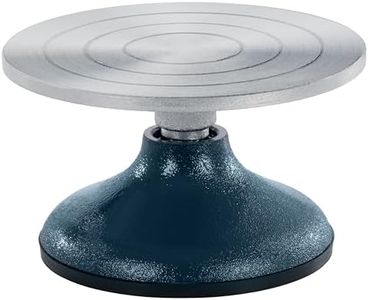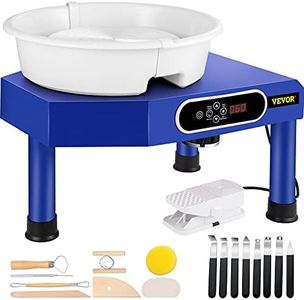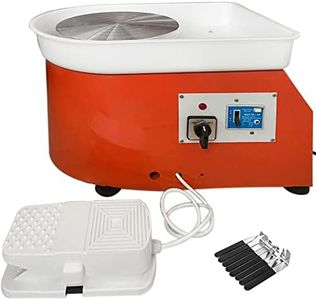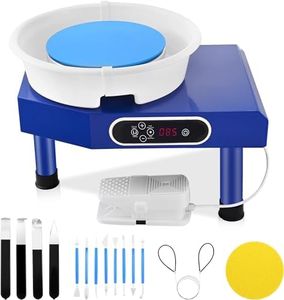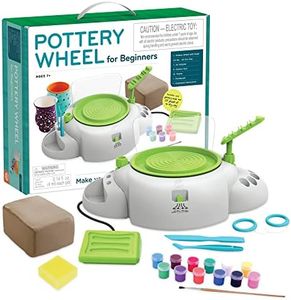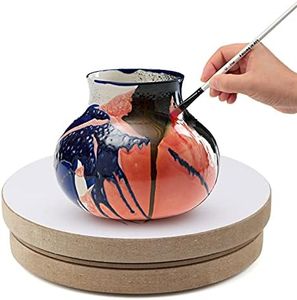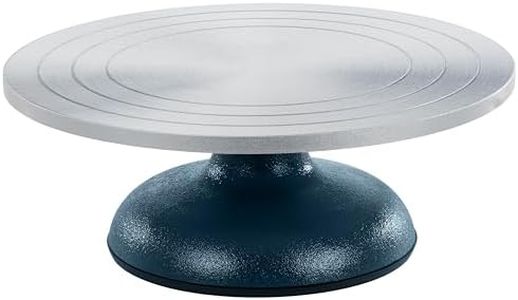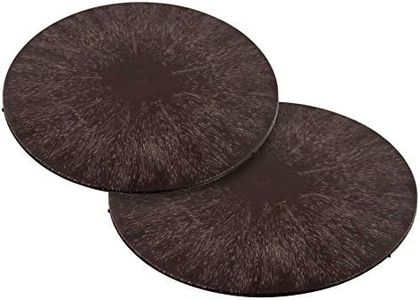4 Best Pottery Wheels For Clay Sculpting 2025 in the United States
Our technology thoroughly searches through the online shopping world, reviewing hundreds of sites. We then process and analyze this information, updating in real-time to bring you the latest top-rated products. This way, you always get the best and most current options available.

Our Top Picks
Winner
VEVOR Pottery Wheel for Adults Beginners, 10in Ceramic Wheel Forming Machine, 60-300RPM Adjustable Speed, Manual LCD Panel and Foot Pedal, Complete Pottery Set for Art Craft Work Home DIY
Most important from
370 reviews
The VEVOR Pottery Wheel is a solid choice for both beginners and more experienced ceramic enthusiasts. Equipped with a robust 350W brushless motor, it handles up to 17.6 lbs of clay smoothly, making it suitable for various sculpting tasks. The 10-inch aluminum alloy turntable offers ample space for most projects. Its dual-speed control system is highly convenient, featuring an LCD screen for precise adjustments and a foot pedal for hands-free speed control. This flexibility enhances the user experience significantly, allowing for both forward and reverse rotation to suit different techniques.
The noise level is impressively low, under 60 dB, which is beneficial for maintaining focus during intricate work. Portability can be a bit of a challenge as the wheel weighs 27 pounds, but this weight also contributes to its solid build quality and stability during use. The removable water basin adds to the ease of cleaning, a critical aspect for any pottery wheel. The included comprehensive tool set is a great addition, making it a good starter kit for beginners and a useful set for seasoned artists.
Durability seems promising with the brushless motor and sturdy construction. However, the product's weight and size may make it less ideal for those needing a highly portable option. This pottery wheel is well-suited for home use and classroom settings, catering effectively to both amateur and professional users.
Most important from
370 reviews
VEVOR Pottery Wheel, Pottery Forming Machine 9.8" LCD Touch Screen, 350W Ceramic Pottery Electric DIY Clay Sculpting Tools, Foot Pedal & Detachable ABS Basin for Adults and Beginners Art Craft
Most important from
130 reviews
The VEVOR Pottery Wheel is a solid choice for both beginners and hobbyists looking for an easy-to-use electric wheel. Its 9.8-inch wheel head is a good size for most clay projects, offering enough space to shape medium-sized pieces. The 350W brushless motor provides a smooth rotation speed up to 300 rpm, which you can easily control via the waterproof LCD touch screen or the convenient foot pedal. This gives a good range of speed adjustments for different clay types and sculpting stages.
The wheel’s body feels sturdy thanks to its spray-treated surface and comes with three heavy-duty metal bases and rubber pads that keep it stable during use, which is especially helpful when working on thicker clay. At 26.5 pounds, it’s moderately portable but not lightweight enough for frequent travel. Brushless motors are generally quieter and more reliable than standard motors. The inclusion of shaping tools is a nice addition for beginners who want to get started right away.
This well-built and user-friendly wheel is not the most compact or lightweight option, and the maximum speed of 300 rpm might feel limiting for more advanced users seeking higher speeds. For those wanting a dependable, straightforward pottery wheel with easy controls and solid stability for casual clay sculpting, this model fits the bill without being overly complex.
Most important from
130 reviews
VEVOR Pottery Wheel 25cm Pottery Forming Machine with Sculpting Set Adjustable Feet Ceramic Pottery Wheel 280W Art Craft DIY Clay Tool for Ceramic Work Ceramics Clay
Most important from
865 reviews
The VEVOR Pottery Wheel 25cm Pottery Forming Machine is a versatile and user-friendly option for both beginners and more experienced ceramic enthusiasts. Its 25cm wheel head is sufficiently large for various sculpting projects, while the 280W motor provides decent power for smooth operation. The adjustable feet and compact design make it quite portable, which is a plus if you need to move it around your workspace or store it away when not in use.
The foot pedal allows for hands-free speed control, enhancing the ease of use, and the ability to switch rotation direction is a nice touch for flexibility in your projects. The machine operates with low noise, which is ideal for maintaining a peaceful working environment. However, at 29.2 pounds, it might be a bit heavy for some users if frequent transportation is required.
The build quality is robust, featuring an aluminum body and an easy-to-clean ABS basin, ensuring durability. One notable safety feature is the earth leakage protection device, providing added peace of mind during operation. While the motor power is sufficient for most tasks, it may not be adequate for very large or highly demanding projects. This pottery wheel is well-suited for educational purposes, home use, and pottery bars, offering a good balance of performance, portability, and safety.
Most important from
865 reviews
Buying Guide for the Best Pottery Wheels For Clay Sculpting
Choosing the right pottery wheel for clay sculpting can significantly impact your crafting experience and the quality of your work. When selecting a pottery wheel, it's essential to consider various factors that align with your skill level, the type of projects you plan to undertake, and your workspace. Understanding the key specifications will help you make an informed decision and ensure that the wheel you choose meets your needs and enhances your sculpting process.FAQ
Most Popular Categories Right Now
